Examples of writing
MLM 2 Ne
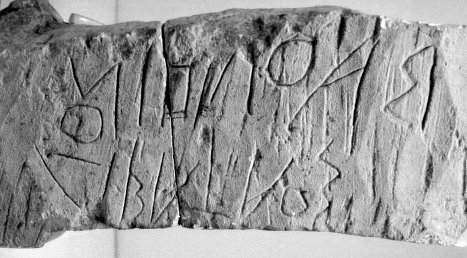
Small stele in pietra leccese stone from Nardò (Lecce)
The inscription, semi-circular and written right to left, is engraved on one side of the stele.
The text reads:
baolihinolibataos
which is to be divided into:
baolihi no libataos
The inscription is dated on the basis of palaeographic data between the first half of the 6th and the first half of the 5th century B.C.
The height of the letters is irregular and their form is rather archaic, as we can notice from the form of alpha, of ny and beta with a particularly long first stroke. The text expresses a masculine name-formula in the genitive case, with the interposition of the verb “to be” (no= latin sum) in the first person singular.
The words Baolihi Libataos are a first name Baolihi (from a stem baole-) and an appositive Libataos, both in the genitive singular. It still remains uncertain whether to assign the value of patronymic or gens/family name to the second element. It is probable that in the Messapic language we are faced with both diachronic and social developments of the second name element in the formula. If in older cases we find patronymic names both for men and for women as the second element, after the introduction of the gens/family element, women continued to be identified only with the patronymic (Untermann 1964).
MLM 1 Vi
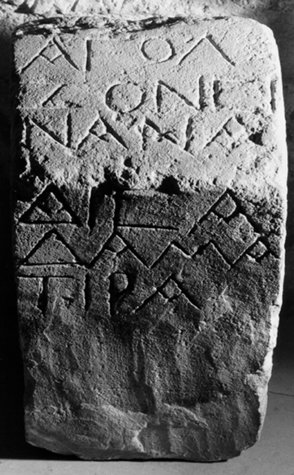
Stone block from Vieste Garganico (FG)
The text is written from left to right on the upper side and continues to another side of the stone. The inscription reads:
a) agol|2zonvi|3nana b) diva|2dama|3tira
The text must be divided as follows:
agolzon vinana diva damatira
The inscription can be dated, according to palaeographic data, between the 4th and the 3rd century B.C. A writing error can be detected on one side of the stone, where the first letter of the word diva, a delta, had first been written as an alpha.
The word algozon, scarcely found (a second example comes from an inscription from Vieste Garganico MLM 2 Vi), remains lexically still obscure, while Vinana can be identified as a feminine personal name, probably a gens/family name, in the nominative singular case.
The word couple Diva Damatira instead occurs other times in the Messapic epigraphy as a feminine goddess name. Damatira turns out to be the Messapic form of the Greek goddess Demeter, and Diva its appositive, which is known also in the form Deiva. This stone, as well as other inscribed stones from Vieste, are of a votive nature.
MLM 31 Me
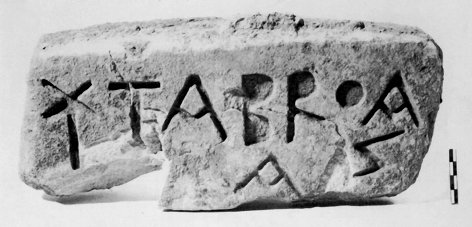
Small carparo stone slab from Mesagne (BR)
The inscription is engraved in two lines written left to right. To the left of the inscription is represented a small St. Andrew’s cross over a vertical stroke, which represent Demeter’s torch.
A forgotten alpha was later reintroduced under the text line, in correspondence to the letter beta. The last letter of the inscription was drawn in a new line below, due to lack of space.
From the form of the letters, particularly the alpha with a middle angled stroke, the rho with a short oblique stroke and the sigma with an upper long stroke, we can refer the inscription to the 3rd century B.C.
It reads:
tabaroa|2s
which is::
tabaroas
The Demeter torch, together with the personal name written in the text (Tabara), allows us to refer the inscription to Demeter‘s cult. Moreover the name Tabara (compare with the Indo-european *to-bhorā; see also the Greek word ϕορός) means “she, who bears (the offers)”, “she priestess”.
In the history of the epigraphic documentation we observe a development in the use of this word, from an original value as appellative to the use as a proper name, followed by a second name (patronymic or gens/family name). The phenomenon called "hieronymy" was pointed out by de Simone in 1982.
MLM 11 Ruv
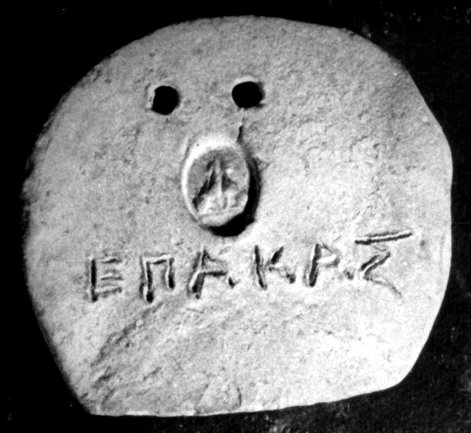
Small discoid clay loom weight from Ruvo (BA).
The weight shows two holes in the upper part and, on the inscribed side, a stamp representing two facing dogs.
The inscription was cut on the raw clay from left to right.
It reads:
epakas
which is a feminine proper name in the genitive case, as often happens in this class of objects.
Most of the weight looms from Ruvo show a cut-pyramidal form and are signed with a feminine proper name in the genitive or nominative case.
MLM 2 Br
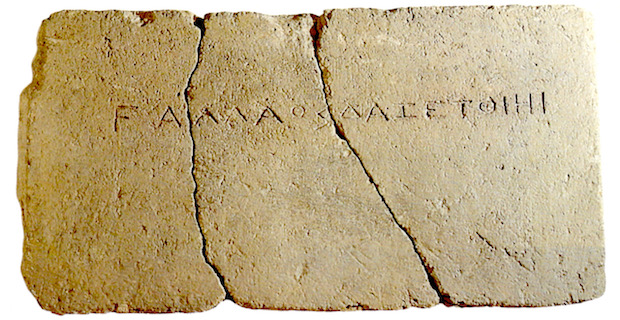
(G. Pugliese Carratelli (ed.), Italia omnium terrarum parens, Milano 1989).
Limestone slab from a grave in Loc. Belvedere, Brindisi. Museo Archeologico Provinciale Fr. Ribezzo, Brindisi. Inv. 648. 3rd c. BCE (MLM 2 Br).
The name of the deceased, made of first (Vallaos) and second name (Dazetθihi) in the genitive, is engraved on one of the internal sides of the stone tomb. Both personal names are well known in Messapic epigraphy.
Stone altar
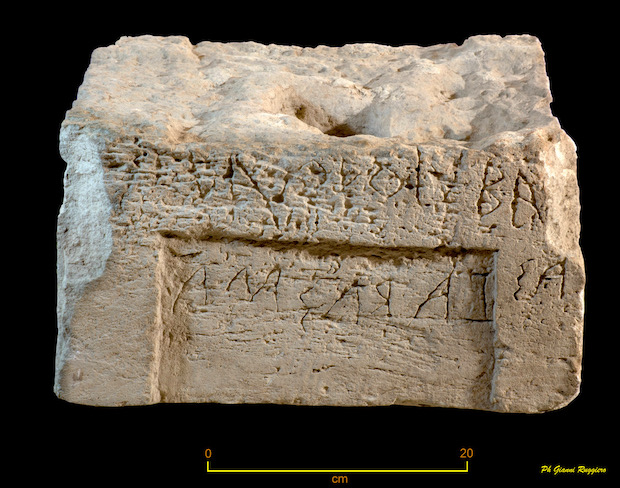
Source: Courtesy F. D’Andria, photo G. Ruggiero
Stone altar from the Athenaion of Castro, Loc. Capanne, Lecce. Museo Archeologico di Castro. 6th c. BCE. (D’Andria 2021).
In 2009, the excavations in Loc. Capanne in Castro carried out by the University of Salento (F. D’Andria) unveiled some inscribed stones and pottery fragments related to a sanctuary dedicated to Tina, probably a local interpretatio of the goddess [MR1] Athena, as the statue of the goddess confirms. The inscribed stone block in the photo was part of an altar. The writing is boustrophedon, and the text can be read as: ]edasoroiba[|2]aszarasma, to be divided into ]edas oroiba […]as zaras ma, in which the word zaras (a personal name) and ma (the prohibitive conjunction) can be recognised. At the moment there is no convincing explanation for the other words.
MLM 19 Cae
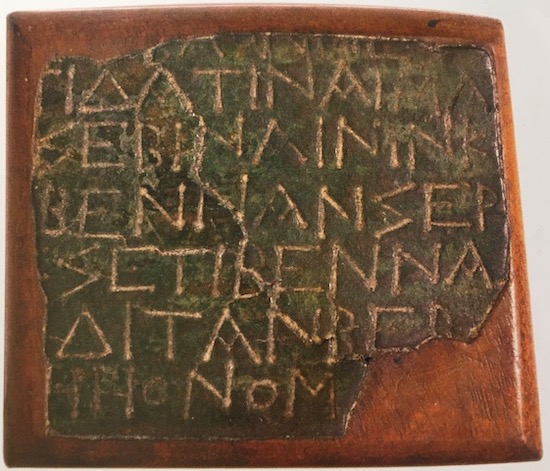
Source: Concessione del Museo Archeologico Provinciale Fr. Ribezzo
Brindisi Bronze table from Ceglie, Monte Vicoli, found in 1877, now at the Museo Archeologico Provinciale Fr. Ribezzo, Brindisi. Inv. 674. 3rd c. BCE (MLM 19 Cae).
The long inscription (7 lines) displays sequences of letters which only sporadically allow reconstructing the sense of the text. The word bennan, accusative singular, refers to a vehicle of some kind, as it appears in other languages (Celtic: benna = ‘vehicle’). Probably also, the name of the goddess Aphrodite can be recognised in the sequence ]dita (for Aprodita?) in the 6th line.
MLM 37 Lup
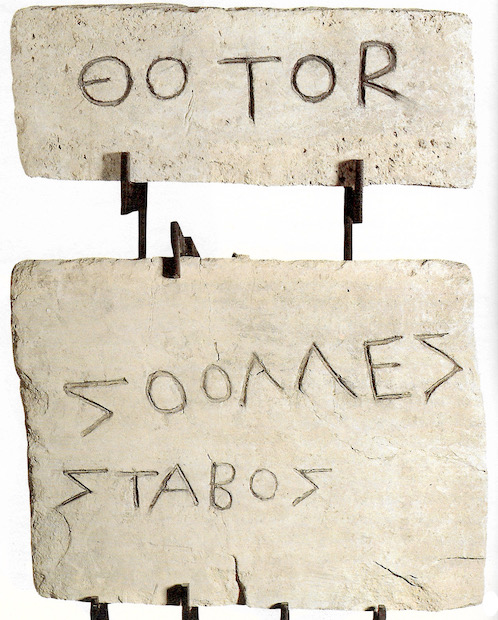
(G. Pugliese Carratelli (ed.), Italia omnium terrarum parens, Milano 1989).
Limestone slabs covering the grave XII of the Amphitheatre’s necropolis, Lecce. Museo Castromediano, Lecce. Nr. 4647-4648, 3rd c. BCE (MLM 37 Lup).
The two limestone slabs, discovered in 1938, are inscribed with an onomastic formula made of three elements: the first name Θotor (similar to the theonym Θaotor) followed by the gentilitial name Soolles, both in the nominative, and the father’s name Stabos in the genitive.
Clay two-handled cup
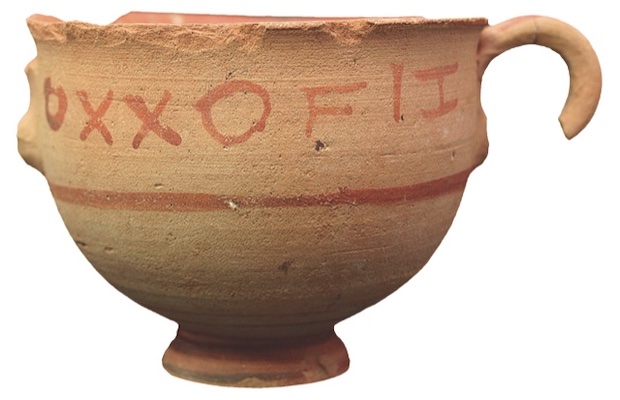
Source: Foto di G. Mastronuzzi
(F. D’Andria, Necessità di un’archeologia delle iscrizioni: tra Taranto, la Messapia e l’Athenaion di Castro, Orizzonti, 23, 2022).
Clay two-handled cup from Piazza Dante, Vaste, Lecce. Dipartimento Scienze Archeologiche, Università di Lecce.
The cup, of local production, displays a red-painted inscription, made before burning: oššoviz. A theonym and personal name Oššo, as well as the feminine derivative Oššova are known from other Messapic inscriptions. The form of the name, terminating in -viz, attested on the small cup is a ‘new entry’ in the documentation of the name.
Wall of Grotta Poesia
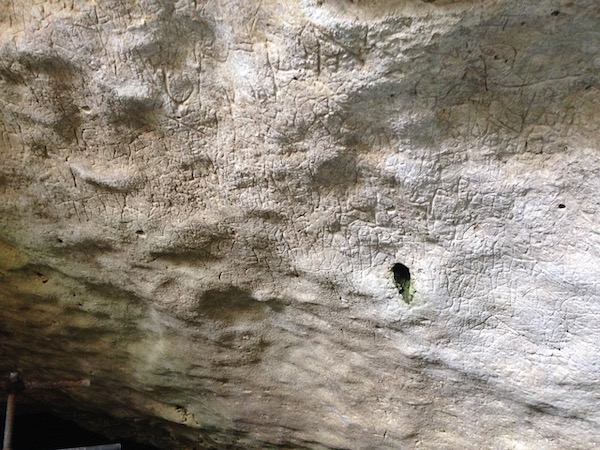
Source: Foto di S. Marchesini, su permesso del Ministero per i Beni e le Attività Culturali, Soprintendenza Archeologia Belle Arti e Paesaggio per le Province di Brindisi e Lecce
Wall of Grotta Poesia at Roca Vecchia, Melendugno (Lecce).
The cave has been frequented by humans since the prehistoric period and most of the 600 square meters of the Grotta are covered by a net of graphic interventions, one over another, made during the use of the cave. Messapic, Latin and a few Greek inscriptions have been recognized until now.